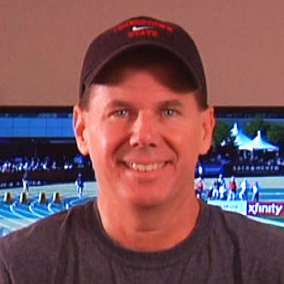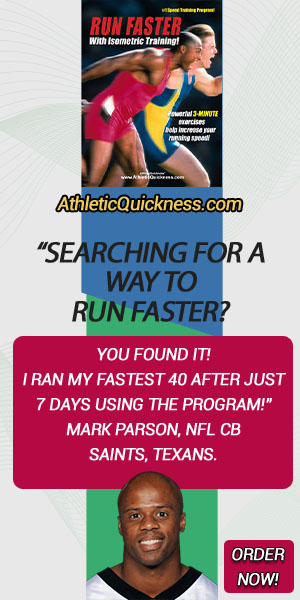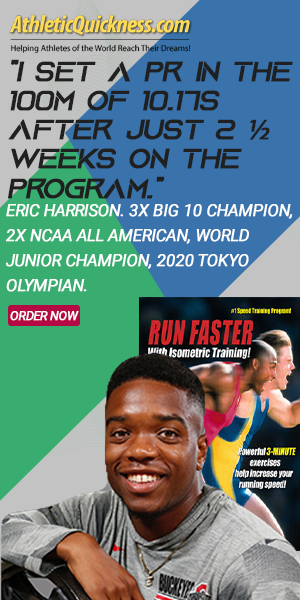
Sports Reaction Time & Closing Speed
Playing defense in any sport requires you to react quickly to your opponent’s moves and change your direction instantly to keep up. The faster your reaction time is to them, the faster you can close in and make a play.
Therefore, to improve your athletic quickness, especially on defense, there are two highly overlooked muscle groups that need to be exercised. These two muscle groups will help you get those hips around quicker and put you in the more dominant athletic position. They are the external and internal hip rotators. Let’s talk about the external hip rotators first.

Fig. 1 – External or Lateral Hip Rotator Muscles
The external hip rotator muscles are shown above in Fig 1. Their names are the Gluteus Maximus, Gluteus Medius, Superior Gemellus, Piriformis, Obturator Internus, Obturator Externus, Inferior Gemellus, and Quadratus Femoris.
Their function is to turn the anterior or, front part of your thigh, outward. This is shown below in Figure 2.

Figure. 2
The reference point for this motion is the front part of the thigh which is in contact with the ground shown. See Figure 2a. As the leg and foot cross over the midline, the front of the thigh can be seen to move laterally, away from the body. See Figure 2b.
One sport activity where this motion is needed is playing defensive back in football. Former NFL cornerback Mark Parson is seen demonstrating a back pedal technique.
As he back pedals and turns, he is opening his hips to the receiver. You can observe this by following the placement of his right leg in the sequence of images in Figure 3 below.

Figure 3. Player Reacts by Opening or Rotating Hips
Initially both feet are facing toward the receiver (Image A) since he doesn’t know which direction they are going to run. Once they commit and he knows which way to turn, he can then react.
In this case, his right hip externally rotates backward and can be seen progressing further in that direction in Images B and C. Again, the muscles responsible for opening the right hip are the external hip rotators from Figure 1.
If he is slow to get into this initial position, he will get beat on the play. So, in order to avoid this, Mark will need to make sure he has trained his external hip rotators to be strong and fast.
INTERNAL or MEDIAL HIP ROTATOR MUSCLES
Now let’s take a look at the counterpart to the external hip rotators, that being, the internal hip rotators.They are the Gluteus Medius (anterior fibers), Gluteus Minimus and Tensor Fascia Lata shown in Figure 4 below.

Figure. 4 – Internal Hip Rotators
Their function is to turn the anterior or, front part of your thigh, inward. This is shown in Figure 5 below.

Figure 5.
The reference point for this motion is the front part of the thigh which is in contact with the ground shown. See Figure 5a. As the leg and foot move outward, away from the midline, the front of the thigh can be seen to move medilly, in toward the body. See Figure 5b.
If you are playing a sport that requires you to turn in any direction before you run, like our example here of Mark playing defensive back, then both of your hips will eventually have to turn in the same direction. But what may not be obvious is that in order to do this, a different set of muscles acting within each hip is required.
In the images seen in Figure 3 above, Mark’s right hip externally rotates first (clockwise) thereby opening both hips in reaction to the receiver. Shortly thereafter, the left hip will eventually turn in the same clockwise direction before he can run. This can be seen in the sequence of images in Figure 6 below.

Fig . 6 – Internal Hip Rotators are engaged to quickly complete the turning motion
In Image A of Figure 6 above, we see Mark’s left leg just starting to react in the same direction as the right. Image B shows more progression in this direction. Finally, in Image C, we now see both hips are turned in the same direction as he heads up field.
But as the right hip externally rotated into this position, a function of the external hip rotators, the left hip had to internally rotate into this position, a function of the internal hip rotators. This is because both muscle groups are on opposite sides of Mark’s midline requiring a different set of muscles to get there.
What Exercises Are You Doing to Train Your Hip Rotator Muscles ?
I have yet to go to a gym and see an exercise machine devoted to training either the external hip rotators or internal hip rotators.
You would think that a joint as valuable as the hip is to an athlete’s performance would have equipment designed to target all six of its planes of motion (flexion, extension, abduction, adduction, internal rotation and external rotation). But there aren’t any.
If you are looking to get a complete hip workout so you can improve your sports reaction time and closing speed quickness and remain competitive in your sport, then you will need to resort to some very creative methods for training them.
Fortunately, our Run Faster Speed Training Program along with the free bonuses, will give you all the tools you need to succeed when it comes to a complete hip workout.



